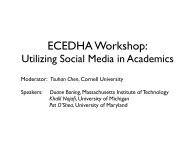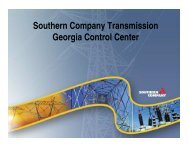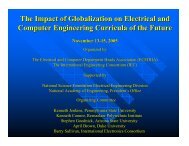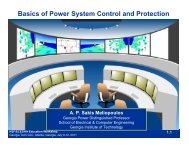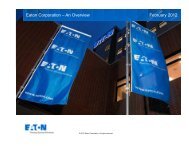Transforming Education in Electric Energy Systems Marija Ilic - ecedha
Transforming Education in Electric Energy Systems Marija Ilic - ecedha
Transforming Education in Electric Energy Systems Marija Ilic - ecedha
Create successful ePaper yourself
Turn your PDF publications into a flip-book with our unique Google optimized e-Paper software.
<strong>Transform<strong>in</strong>g</strong> <strong>Education</strong> <strong>in</strong> <strong>Electric</strong> <strong>Energy</strong><br />
<strong>Systems</strong><br />
<strong>Marija</strong> <strong>Ilic</strong><br />
Professor of <strong>Electric</strong>al and Computer Eng<strong>in</strong>eer<strong>in</strong>g<br />
and Eng<strong>in</strong>eer<strong>in</strong>g and Public Policy<br />
milic@ece.cmu.edu<br />
ECEDHA <strong>Energy</strong> Workshop<br />
November 1,2010
Outl<strong>in</strong>e<br />
Boom-and-bust cycles of electric energy systems<br />
education <strong>in</strong> the United States<br />
Difficult <strong>in</strong>itial conditions<br />
Societal transformational changes ---<br />
implement<strong>in</strong>g susta<strong>in</strong>able Socio-Ecological <strong>Energy</strong><br />
<strong>Systems</strong> (SEES)<br />
The transformational role of man-made power<br />
grids and its Information Communications<br />
Technology (ICT)?
Many boom-and-bust cycles <strong>in</strong> the US electric energy<br />
education<br />
Boom #1 : The biggest contribution of the 20 th century –<br />
electrification; Well established programs (even entire<br />
departments on electric power eng<strong>in</strong>eer<strong>in</strong>g—RPI).<br />
Bust #1: Clos<strong>in</strong>g of power eng<strong>in</strong>eer<strong>in</strong>g programs and labs at<br />
lead<strong>in</strong>g universities; education and research on life support.<br />
Boom #2: Restructur<strong>in</strong>g of electric power <strong>in</strong>dustry--- economics,<br />
policy discipl<strong>in</strong>es ga<strong>in</strong> recognition. Eng<strong>in</strong>eer<strong>in</strong>g knowledge<br />
assumed.<br />
Bust #2: Restructur<strong>in</strong>g problems –markets ``not work<strong>in</strong>g’’—<br />
they never were designed nor implemented to support physics of<br />
electric power grids.<br />
Boom #3: <strong>Energy</strong> and environment emerge as key social goals.<br />
Young m<strong>in</strong>ds very excited and motivated to make the vision a<br />
reality.<br />
Bust#3--??? The biggest danger--- overwhelm<strong>in</strong>g complexity;<br />
change driven by technology breakthroughs, social drivers. A<br />
very real danger of not meet<strong>in</strong>g the expectations.
Difficult Initial Initial Conditions Conditions<br />
For a long time not recognized as the key <strong>in</strong>tellectual<br />
discipl<strong>in</strong>e<br />
<br />
- complexity of problems the same as <strong>in</strong> <strong>in</strong>tegrated circuits,<br />
healthcare, transportation, and many other complex network<br />
systems.<br />
Hard to attract the best young m<strong>in</strong>ds<br />
- fund<strong>in</strong>g and <strong>in</strong>stitutional encouragement lack<strong>in</strong>g<br />
- electric power <strong>in</strong>dustry has not offered the most excit<strong>in</strong>g jobs<br />
- non-competitive salaries<br />
``The only <strong>in</strong>dustry <strong>in</strong> which it is impossible to do<br />
<strong>in</strong>novation’’ (quote from a major venture capitalist)<br />
Mov<strong>in</strong>g forward--Requires patience and<br />
perseverance
Transformational Social Changes:<br />
Natural Socio-Ecological <strong>Energy</strong> <strong>Systems</strong><br />
(SEES) <strong>in</strong>teract<strong>in</strong>g with the man-made<br />
<strong>in</strong>frastructures<br />
Recent framework for characteriz<strong>in</strong>g<br />
natural SESs ; core- and second-level<br />
variables [1]<br />
Man-made <strong>in</strong>frastructure design problem:<br />
Make any given natural SEES as susta<strong>in</strong>able<br />
as possible [2]
Some New Problem Pos<strong>in</strong>g Challenges<br />
Def<strong>in</strong>e core sub-system variables of an SEES<br />
Def<strong>in</strong>e second- (and deeper)-level variables key to<br />
answer<strong>in</strong>g questions of <strong>in</strong>terest<br />
Establish measures (qualitative and quantitative) of<br />
second- and deeper-level variables<br />
Use these to determ<strong>in</strong>e key factors for assess<strong>in</strong>g the<br />
likelihood of the given SEES to be susta<strong>in</strong>able and for<br />
policy design
Core and Second-Level Variables [1]
“Smart Grid” electric power grid and<br />
ICT for susta<strong>in</strong>able energy SES [2]<br />
<strong>Energy</strong> SES<br />
• Resource<br />
system (RS)<br />
• Generation<br />
Man-made<br />
Grid<br />
• Physical<br />
network<br />
Man-made<br />
ICT<br />
• Sensors<br />
• Communica
L<strong>in</strong>k<strong>in</strong>g physical design and ICT<br />
Characteristics of second-order variables <strong>in</strong> the natural<br />
energy SESs critically affected by the man-made<br />
<strong>in</strong>frastructure design<br />
The role of deeper-level variables for design<strong>in</strong>g<br />
susta<strong>in</strong>able electric energy systems [3]<br />
Ma<strong>in</strong> objective of a “Smart Grid” Design--- Design the<br />
physical power grid, ICT and governance policies to<br />
match desired attributes of the core SES energy subsystems<br />
If/when done right, this <strong>in</strong>duces susta<strong>in</strong>able<br />
properties of the second-level variables; no blue-pr<strong>in</strong>t<br />
approach
Transformational changes <strong>in</strong> the objectives of<br />
Today’s T&D Grid<br />
Tomorrow’s T&D Grid<br />
Deliver supply to meet given demand<br />
Deliver power to support supply and<br />
demand schedules <strong>in</strong> which both supply<br />
and demand have costs assigned<br />
Deliver power assum<strong>in</strong>g a predef<strong>in</strong>ed tariff Deliver electricity at QoS determ<strong>in</strong>ed by<br />
the customers will<strong>in</strong>gness to pay<br />
Deliver power subject to predef<strong>in</strong>ed CO 2<br />
constra<strong>in</strong>t<br />
Deliver supply and demand subject to<br />
transmission congestion<br />
Deliver power def<strong>in</strong>ed by users’<br />
will<strong>in</strong>gness to pay for CO 2<br />
Schedule supply, demand and transmission<br />
capacity (supply, demand and transmission<br />
costs assigned); transmission at value<br />
Use storage to balance fast vary<strong>in</strong>g<br />
supply and demand<br />
Build new transmission l<strong>in</strong>es for forecast<br />
demand<br />
Build storage accord<strong>in</strong>g to customers<br />
will<strong>in</strong>gness to pay for be<strong>in</strong>g connected to a<br />
stable grid<br />
Build new transmission l<strong>in</strong>es to serve<br />
customers accord<strong>in</strong>g to their ex ante<br />
(longer-term) contracts for service
THE MOST DIFFICULT QUESTIONS<br />
Establish sufficiently accurate (but not too complex)<br />
model<strong>in</strong>g framework which captures <strong>in</strong>ter-dependencies<br />
between energy SES, physical grid, ICT and governance<br />
system<br />
The key objective: Match attributes of core variables <strong>in</strong> the<br />
composite energy SES; do it by careful model-based<br />
design of physical grid, ICT and governance system for a<br />
specific type of energy SES
Fully regulated bulk electric energy system
Hybrid <strong>Electric</strong> <strong>Energy</strong> System
ICT design to monitor and control <strong>in</strong>teraction variables
Match<strong>in</strong>g Temporal Characteristics - 50% W<strong>in</strong>d Integration<br />
15
Future electric energy systems programs<br />
Must educate the next generation work force<br />
Must do so <strong>in</strong> the context of, and centered <strong>in</strong>,<br />
<strong>Electric</strong>al and Computer Eng<strong>in</strong>eer<strong>in</strong>g (ECE)<br />
Must <strong>in</strong>tegrate ECE with other academic discipl<strong>in</strong>es<br />
Must also address non-technical issues (policy,<br />
economics)<br />
Recent awareness of an educational void, and a<br />
sense of urgency to <strong>in</strong>novate and <strong>in</strong>tegrate<br />
electric energy systems education, <strong>in</strong>to exist<strong>in</strong>g
Transformational changes <strong>in</strong> educat<strong>in</strong>g<br />
Reth<strong>in</strong>k how to plan, rebuild and operate an<br />
<strong>in</strong>frastructure which has been turned upside-down<br />
from what it used to be<br />
Leaders must understand <br />
3ϕ physics (the basic foundations)<br />
Model<strong>in</strong>g of complex systems (architecturedependent<br />
models, components and their<br />
<strong>in</strong>teractions, performance objectives)<br />
Dependence of models on sensors and<br />
actuators; design for desired system<br />
performance (def<strong>in</strong>ed by economic policy and<br />
eng<strong>in</strong>eer<strong>in</strong>g specifications)<br />
Numerical methods and algorithms
Objectives for modern electric energy systems<br />
Not only a novel education, but multi-discipl<strong>in</strong>ary<br />
coverage across ECE and beyond<br />
Provide conceptual problem formulations<br />
(understand how models, sens<strong>in</strong>g, control and<br />
communication are different for sample systems: 1)<br />
old centralized <strong>in</strong>frastructure; (2) deregulated<br />
<strong>in</strong>dustry; and, (3) <strong>in</strong>dustry with lots of distributed<br />
sensors, controllers, <strong>in</strong>termittent generation,<br />
demand-side.)<br />
Introduce novel simulators/graphics/visualization<br />
to teach these concepts.
Modern <strong>Electric</strong> <strong>Energy</strong> <strong>Systems</strong> at at Carnegie<br />
Lots of fun; the number of graduate students is high and<br />
grow<strong>in</strong>g; the number of students tak<strong>in</strong>g classes is high<br />
and grow<strong>in</strong>g. Grass-root pressure from students.<br />
Students genu<strong>in</strong>ely <strong>in</strong>terested <strong>in</strong> careers <strong>in</strong> future energy<br />
systems (drawn to the area to serve mank<strong>in</strong>d while still<br />
do<strong>in</strong>g eng<strong>in</strong>eer<strong>in</strong>g)<br />
Emphasis on systems formulation (<strong>in</strong>stead of on<br />
component physics); smart grid as an enabler.<br />
Much novel model<strong>in</strong>g for “translat<strong>in</strong>g” a physical and<br />
bus<strong>in</strong>ess system and its objectives <strong>in</strong>to the language of<br />
systems, control, sensors, signal process<strong>in</strong>g, computer<br />
science and IT; power electronics-enabled control.<br />
Team-teach<strong>in</strong>g with bus<strong>in</strong>ess and public policy faculty.<br />
<strong>Energy</strong> Master’s Program across Eng<strong>in</strong>eer<strong>in</strong>g, Science<br />
and Technology http://neon.materials.cmu.edu/<br />
energy/<br />
A GREAT ECE DEPARTMENT HEAD MAKES ALL THE
<strong>Electric</strong> <strong>Energy</strong> <strong>Systems</strong> Group (EESG) http://<br />
www.eesg.ece.cmu.edu<br />
A multi-discipl<strong>in</strong>ary group of researchers from<br />
across Carnegie Mellon with common <strong>in</strong>terest<br />
<strong>in</strong> electric energy.<br />
Truly <strong>in</strong>tegrated education and research<br />
Interests range across technical, policy,<br />
sens<strong>in</strong>g, communications, comput<strong>in</strong>g and<br />
much more; emphasis on systems aspects of<br />
the chang<strong>in</strong>g <strong>in</strong>dustry, model-based<br />
simulations and decision mak<strong>in</strong>g/control for<br />
predictable performance.<br />
Home of the new SRC Smart Grid Research<br />
Center<br />
http://www.ece.cmu.edu/news/story/2010/07/<br />
carnegie_mellon_to/
DYMONDS-enabled Physical Grid [4]
A sample of subjects currently offered <strong>in</strong><br />
18-418 <strong>Electric</strong> <strong>Energy</strong> Process<strong>in</strong>g: Fundamentals and<br />
Applications<br />
18-875/19-633/45-855/45-856 Eng<strong>in</strong>eer<strong>in</strong>g and<br />
Economics Problems <strong>in</strong> Future <strong>Electric</strong> <strong>Energy</strong> <strong>Systems</strong><br />
18-618 Smart Grids and Future <strong>Electric</strong> <strong>Energy</strong> <strong>Systems</strong><br />
18-777 Large-scale Dynamic <strong>Systems</strong><br />
Courses taught with an eye on regulatory, technological<br />
changes, and the implications of these on problem<br />
pos<strong>in</strong>g and possible solutions.<br />
Courses emphasize commonalities across different<br />
electric energy systems (power systems-power<br />
distribution to homes; shipboards, aircrafts and cars.<br />
In house software development to support the<br />
curriculum – (Graphical) Interactive Power <strong>Systems</strong><br />
Simulator ((G)IPSYS).<br />
Many courses outside ECE
Clos<strong>in</strong>g Remarks<br />
There exists now a highly unusual w<strong>in</strong>dow of<br />
opportunity to <strong>in</strong>troduce modern electric energy<br />
research and education programs<br />
Obvious societal needs<br />
CMU is a great environment<br />
Boundaries across discipl<strong>in</strong>es fluid<br />
Very strong discipl<strong>in</strong>es needed for develop<strong>in</strong>g embedded<br />
<strong>in</strong>telligence (CS, security, sensor networks, signal<br />
process<strong>in</strong>g)<br />
We will waste this rare opportunity without a full<br />
understand<strong>in</strong>g of the potential of embedd<strong>in</strong>g ITenabled<br />
<strong>in</strong>telligence with<strong>in</strong> complex physical energy<br />
systems
References<br />
[1] El<strong>in</strong>or Ostrom, et al, A General Framework for<br />
Analyz<strong>in</strong>g Susta<strong>in</strong>ability of social-Ecological <strong>Systems</strong>,<br />
Science 325, 419 (2009).<br />
[2] <strong>Ilic</strong>, M, et al, A Decision Mak<strong>in</strong>g Framework and<br />
Simulator for Susta<strong>in</strong>able <strong>Electric</strong> <strong>Energy</strong> <strong>Systems</strong>, The<br />
IEEE Trans. On Susta<strong>in</strong>able <strong>Energy</strong>, TSTE-00011-2010<br />
(January 2011).<br />
[3] <strong>Ilic</strong>, M., dynamic Monitor<strong>in</strong>g and Decision <strong>Systems</strong><br />
for Susta<strong>in</strong>able Services, Proc. of IEEE, January 2011.<br />
[4] ERi SRC Smart Grid Research Center at Carnegie<br />
Mellon University,<br />
http://www.ece.cmu.edu/news/story/2010/07/<br />
carnegie_mellon_to/



